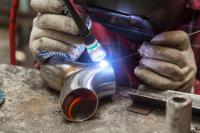 Add My Company
Add My Company
Sign In
PIPE WELDING FAQ
11-03-2020

If you’ve ever wondered how to weld a pipe, this is your ultimate guide and FAQ. Here you can find tips for exhaust pipes, pipeline, and what butt fusion welding really means.
How to: Exhaust Welding
As with any welding, it is paramount that you clean the workpieces before you begin. Neglecting to clean your workpieces can interfere with the quality of the weld, which means that you are risking your weld’s integrity from the beginning.
First, you will need to cut the exhaust pipe where you will be welding it. If you are welding your exhaust pipe because your vehicle has suffered issues with rust, you should grind away the corrosion as part of the cleaning process. Any remaining rust that is present at the end of your weld could spread to the new metal and cause you to have to repeat the job.
You should also grind down the edges where you have cut away the pipe to remove any imperfections.
It is also important that you thoroughly understand the metals that you are working with before you begin, as this will determine the type of welding rod you should be using, as well as temperature. Different welds require different shielding gases, too. We provide MIG welding gas and TIG welding gas for hobbyists and businesses.
You’ll need to clamp the tubing together because you’ll need both hands free for welding. Take care when you clamp them together because there’s no going back once you start welding.
Do some spot welds around the seam that you’re going to be welding. These spot welds will further help to keep the piping together during the weld. Without the spot welds, the pipe may warp under the intense heat of your welding torch, so this is a good precaution to take.
Finally, complete your weld. Take care not to leave any gaps as this could lead to leaks in the exhaust.
For more information on PIPE WELDING FAQ talk to Adams Gas
Enquire Now
List your company on FindTheNeedle.

